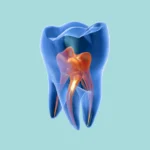Doctor, a patient walks into your clinic complaining that their teeth feel shorter than before, or their shape has changed, becoming noticeably flatter. When you ask if they grind their teeth at night, they might say yes, or perhaps they haven’t even noticed it themselves.
This complaint is a classic sign of one of the most common conditions we encounter daily in practice: attrition. Let’s delve into it, with a focus on its radiographic presentation.
What Exactly is Attrition?
Simply put, Doctor, attrition is a physiological wearing away of tooth structure that occurs due to direct tooth-to-tooth contact. This condition is very often linked to bruxism, or teeth grinding.
What Does It Look Like on X-rays? (Radiographic Features)
To easily identify attrition on radiographs, pay close attention to these specific details:
-
Location: This wear is typically found on the incisal surfaces of anterior teeth and the occlusal surfaces of posterior teeth.
-
Edge: The boundaries of the wear are usually quite well-defined.
-
Shape: You’ll notice that the occlusal plane appears flattened, often presenting as a flat occlusal plane. You’ll also observe a reduced crown height.
-
Internal Composition: You’ll likely see radiolucent areas on the incisal and occlusal surfaces. This occurs because the enamel layer has been worn away, leading to a diminished radiopacity in these specific regions.
-
Number: It often affects all anterior teeth. In more severe instances, it can extend to involve all teeth.
Key Diagnostic Signs
The two most significant radiographic signs are:
-
Generalized flattening of occlusal/incisal surfaces.
-
Uniform reduction in crown height.
Why is It Clinically Important? (Clinical Significance)
We really must pay close attention to attrition because if left unmanaged, it can lead to several complications:
-
A decrease in the vertical dimension of occlusion.
-
Potential temporomandibular joint problems.
-
Increased tooth sensitivity due to the loss of the protective enamel layer.
-
Severe cases might even necessitate full mouth rehabilitation.
More often than not, this condition is a clear indicator that your patient requires a night guard to prevent further tooth wear.
A Crucial Point in Diagnosis and Treatment
It’s vital to understand, Doctor, that radiographs alone are insufficient; a thorough clinical examination is absolutely essential for a complete assessment. You must differentiate attrition from abrasion and erosion to ensure accurate treatment planning. Most importantly, identifying and addressing the primary underlying cause—such as stress or malocclusion—is paramount to ensure the long-term success of your intervention.



















